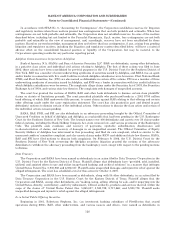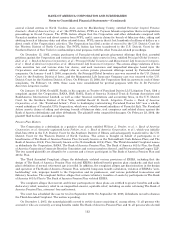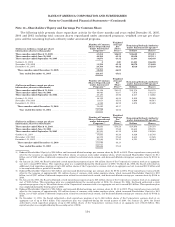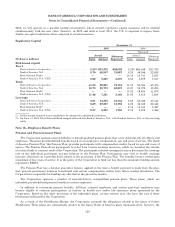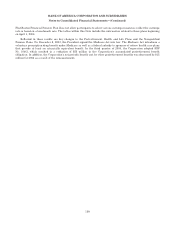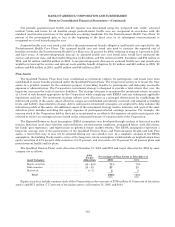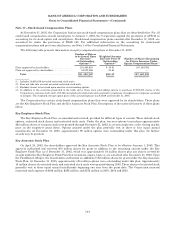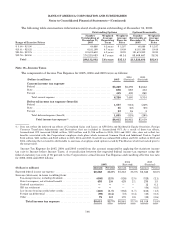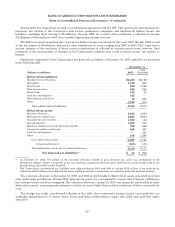Bank of America 2005 Annual Report Download - page 173
Download and view the complete annual report
Please find page 173 of the 2005 Bank of America annual report below. You can navigate through the pages in the report by either clicking on the pages listed below, or by using the keyword search tool below to find specific information within the annual report.BANK OF AMERICA CORPORATION AND SUBSIDIARIES
Notes to Consolidated Financial Statements—(Continued)
N.A. (USA) were classified as well-capitalized under this regulatory framework. There have been no conditions or events
since December 31, 2005 that management believes have changed the Corporation’s, Bank of America, N.A.’s and Bank
of America, N.A. (USA)’s capital classifications.
The regulatory capital guidelines measure capital in relation to the credit and market risks of both on and
off-balance sheet items using various risk weights. Under the regulatory capital guidelines, Total Capital consists of
three tiers of capital. Tier 1 Capital includes Common Shareholders’ Equity, Trust Securities, minority interests and
qualifying Preferred Stock, less Goodwill and other adjustments. Tier 2 Capital consists of Preferred Stock not qualifying
as Tier 1 Capital, mandatory convertible debt, limited amounts of subordinated debt, other qualifying term debt, the
allowance for credit losses up to 1.25 percent of risk-weighted assets and other adjustments. Tier 3 Capital includes
subordinated debt that is unsecured, fully paid, has an original maturity of at least two years, is not redeemable before
maturity without prior approval by the FRB and includes a lock-in clause precluding payment of either interest or
principal if the payment would cause the issuing bank’s risk-based capital ratio to fall or remain below the required
minimum. Tier 3 Capital can only be used to satisfy the Corporation’s market risk capital requirement and may not be
used to support its credit risk requirement. At December 31, 2005 and 2004, the Corporation had no subordinated debt
that qualified as Tier 3 Capital.
Certain corporate sponsored trust companies which issue trust preferred securities (Trust Securities) are not
consolidated under FIN 46R. As a result, the Trust Securities are not included on our Consolidated Balance Sheets. On
March 1, 2005, the FRB issued Risk-Based Capital Standards: Trust Preferred Securities and the Definition of Capital
(the Final Rule) which allows Trust Securities to continue to qualify as Tier 1 Capital with revised quantitative limits
that would be effective after a five-year transition period. As a result, Trust Securities are included in Tier 1 Capital.
The FRB’s Final Rule limits restricted core capital elements to 15 percent for internationally active bank holding
companies. Internationally active bank holding companies are those with consolidated assets greater than $250 billion or
on-balance sheet exposure greater than $10 billion. At December 31, 2005, our restricted core capital elements comprised
16.6 percent of total core capital elements. In addition, the FRB revised the qualitative standards for capital instruments
included in regulatory capital. We expect to be fully compliant with the revised limits prior to the implementation date of
March 31, 2009.
On July 28, 2004, the FRB and other regulatory agencies issued the Final Capital Rule for Consolidated Asset-
backed Commercial Paper Program Assets (the Final Rule). The Final Rule allows companies to exclude from risk-
weighted assets, the assets of consolidated asset-backed commercial paper (ABCP) conduits when calculating Tier 1 and
Total Risk-based Capital ratios. The Final Rule also requires that liquidity commitments provided by the Corporation to
ABCP conduits, whether consolidated or not, be included in the capital calculations. The Final Rule was effective
September 30, 2004. There was no material impact to Tier 1 and Total Risk-based Capital as a result of the adoption of
this rule.
To meet minimum, adequately-capitalized regulatory requirements, an institution must maintain a Tier 1 Capital
ratio of four percent and a Total Capital ratio of eight percent. A well-capitalized institution must generally maintain
capital ratios 200 bps higher than the minimum guidelines. The risk-based capital rules have been further
supplemented by a leverage ratio, defined as Tier 1 Capital divided by adjusted quarterly average Total Assets, after
certain adjustments. The leverage ratio guidelines establish a minimum of three percent. Banking organizations must
maintain a leverage capital ratio of at least five percent to be classified as well-capitalized. As of December 31, 2005, the
Corporation was classified as well-capitalized for regulatory purposes, the highest classification.
Net Unrealized Gains (Losses) on AFS Debt Securities, Net Unrealized Gains on AFS Marketable Equity Securities
and the Net Unrealized Gains (Losses) on Derivatives included in Shareholders’ Equity at December 31, 2005 and 2004,
are excluded from the calculations of Tier 1 Capital and leverage ratios. The Total Capital ratio excludes all of the above
with the exception of up to 45 percent of Net Unrealized Gains on AFS Marketable Equity Securities.
Regulatory Capital Developments
In June 2004, the Basel Committee on Banking Supervision issued a new set of risk-based capital standards (Basel
II) with the intent of more closely aligning regulatory capital requirements with underlying risk. In August 2003, the
U.S. regulatory agencies drafted the Advanced Notice of Proposed Rulemaking to establish a comparable rule for large
U.S. financial institutions. The final rule, which is expected to be issued during the second quarter of 2006, will provide
us with clarification as to the requirements under U.S. regulations.
Several of our international units will begin implementing Basel II locally during 2006, with full implementation by
2007. U.S. regulatory agencies have delayed implementation of Basel II for the consolidated entity until 2008. During
137



